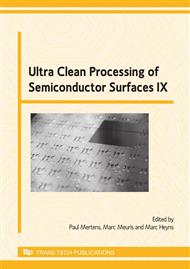p.249
p.253
p.257
p.261
p.265
p.269
p.273
p.277
p.281
Shortening of Plasma Strip Process Resulting in Better Removal of Photo Resist after High Dose Implantation
Abstract:
A layer of hardened material (crust) forms on the surface of photo resist (PR) during the implantation. This crust can be described as highly cross-linked polymer [1, 2]. Its thickness and composition depends on the type of PR, implant species, energy, dose, temperature during implantation and other factors. The crust is very resistant against chemical attack. Its chemical resistance tends to increase with the continuous shrink of technology nodes as implant doses increase. Moreover, even small residues of PR, left after cleaning, become more critical with shrinking device geometry. The usual process sequence for stripping a PR after high dose implantation (HDI) is a plasma strip (PS) followed by a wet clean. The drawback of plasma ashing is increased substrate loss and dopant bleach [3]. Plasma strip or plasma ash stand in this paper for the approach of complete PR consumption in the plasma process. Wet stripping alone often is not sufficient for stripping PR after implant doses of ≥ 1x1015 ions/cm2.
Info:
Periodical:
Pages:
265-268
Citation:
Online since:
January 2009
Authors:
Price:
Сopyright:
© 2009 Trans Tech Publications Ltd. All Rights Reserved
Share:
Citation:


